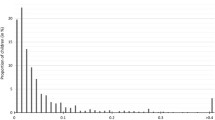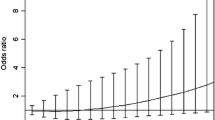Abstract
Magnetic field levels were studied in an urban area—the city of Cáceres (Spain). The study included systematic spot measurements throughout the city, an analysis of the temporal variation of the magnetic field, and the incorporation of the data into a geographic information system. The levels detected were at most 7.3% of the ICNIRP reference levels, and the highest fields were found in the oldest neighborhoods. Considered overall, the ELF magnetic flux density levels determined in the present study were between those found in residential and in working environments. Knowledge of the levels of such fields in urban areas is therefore fundamental in evaluating the population’s overall exposure, especially for people who work outdoors.





Similar content being viewed by others
References
Wertheimer N, Leeper E (1979) Electric wiring configurations and childhood cancer. Am J Epidemiol 109:273–384
Fleychting M, Ahlbom A (1993) Magnetic fields and cancer in children residing near Swedish high-voltage power lines. Am J Epidemiol 138:467–481
Green LM, Miller AB, Agnew AB (1999) Childhood leukemia and personal monitoring of residential exposures to electric and magnetic fields in Ontario, Canada. Cancer Causes Control 10:233–243
Tomenius L (1986) 50 Hz electromagnetic environment and the incidence of childhood tumors in Stockholm country. Bioelectromagnetics 7:191–202
Coleman MP, Bell CMG, Taylor HL, Primic-Zakelj M (1989) Leukemia and residence near electricity transmission equipment a case-control study. Br J Cancer 60:793–798
IARC (2000) Non-ionizing radiation, Part I: Static and extremely low frequency (ELF) electric and magnetic fields, vol 80. International Agency for Research on Cancer Monographs
WHO 1984 Extremely Low Frequency (ELF) Fields. Environmental Health Criteria 35. World Health Organization, Geneva
ICNIRP (1998) International Commission on Non-Ionizing Radiation Protection. Guidelines for limiting exposure to time-varying electric, magnetic and electromagnetic fields. Health Phys 74:494–522
Lindgren M, Gustavsson M, Hamnerius Y, Galt S (2001) ELF magnetic fields in a city environment. Bioelectromagnetics 22:87–90
d’Amore G, Anglesio L, Tasso M, Benedetto A, Roletti S (2001) Outdoor background ELF Magnetic fields in an urban environment. Radiat Prot Dosim 94(4):375–380
Paniagua JM, Jiménez A, Rufo M, Antolín A (2004) Exposure assessment of ELF magnetic fields in urban environments in Extremadura (Spain). Bioelectromagnetics 25:58–62
Delaunay B (1934) Sur la sphere vide. Bull Acad Sci URSS 7:793–800
IEEE (1995) IEEE Standard Procedures for Measurement of Power Frequency Electric and Magnetic Fields from AC Power Lines. The Institute of Electrical and Electronics Engineers, Inc, USA
International Standard ISO 9001:1994 Quality Systems (1994) Model for quality assurance in design, development, production, installation and servicing. International Organization for Standardization, Geneva, Switzerland
Hornung RW, Reed LD (1990) Estimation of average concentration in the presence of nondetectable values. Appl Occup Environ Hyg 5(1):46–51
Royal Decree 1066/2001, of 28 September, Approving the regulation that sets conditions of protection of the public radio-electrical domain, restrictions on radio-electrical emissions, and health protection measures against radio-electrical emissions. B.O.E. no. 234, 29 September 2001
Clinard F, Milan C, Harb M, Carli PM, Bonithon-Kopp C, Moutet JP, Faivre J, Hillon P (1999) Residential magnetic field measurements in France: comparison of indoor and outdoor measurements. Bioelectromagnetics 20:319–326
Swanson J (1997) Does the exposure of children in the UK to background residential power-frequency magnetic fields differ from that of the whole population? J Radiol Prot 17(2):111–113
Merchant CJ, Renew DC, Swanson J (1994) Exposures to power-frequency magnetic fields in the home. J Radiol Prot 14:77–87
Schüz J, Grigat JP, Störmer B, Rippin G, Brinkmann K, Michaelis J (2000) Extremely low frequency magnetic fields in residences in Germany. Distribution of measurements, comparison of two methods for assessing exposure, and predictors for the occurrence of magnetic fields above background level. Radiat Environ Biophys 39:233–240
Eskelinen T, Juutilainen J, Toivonen T, Jokela K, Keskinen K (2001) Occupational exposure to magnetic fields for EAS devices. Bioelectromagnetic Society Annual Meeting, St. Paul, Minnesota, USA. Abstract Collection, 101–102
Kelsh MA, Bracken TD, Sahl JD, Shum M, Ebi K (2001) Magnetic-field exposures of garment workers: results of personal and survey measurements and a pilot interview study. Bioelectromagnetic Society Annual Meeting, St Paul, Minnesota, USA. Abstract Collection, 21
Merchant CJ, Renew DC, Swanson J (1994) Occupational exposures to power-frequency magnetic fields in the electricity supply industry. J Radiol Prot 14(2):155–164
Karpowicz GK (2001) Occupational exposure to magnetic fields in 6–400 kV substations.5th International Congress of the European Bioelectromagnetics Association (EBEA). Helsinki, Finland pp 144–146
Van Wijngaarden E, Nylander-French LA, Millikan RC, Savitz DA, Loomis D (2001) Population-based case-control study of occupational exposure to electromagnetic fields and breast cancer. Ann Epidemiol 11(5):297–303
Acknowledgments
The authors are grateful to Mr. José Luis Sánchez, for his collaboration in this paper, and to the Consejería de Educación, Ciencia y Tecnología of the Junta de Extremadura for financing the present study within the framework of the research project “Map of Electromagnetic Contamination of the City of Cáceres. Integration in a geographic information system. IPR00B003”.
Author information
Authors and Affiliations
Corresponding author
Rights and permissions
About this article
Cite this article
Paniagua, J.M., Jiménez, A., Rufo, M. et al. Exposure to extremely low frequency magnetic fields in an urban area. Radiat Environ Biophys 46, 69–76 (2007). https://doi.org/10.1007/s00411-006-0081-0
Received:
Accepted:
Published:
Issue Date:
DOI: https://doi.org/10.1007/s00411-006-0081-0




